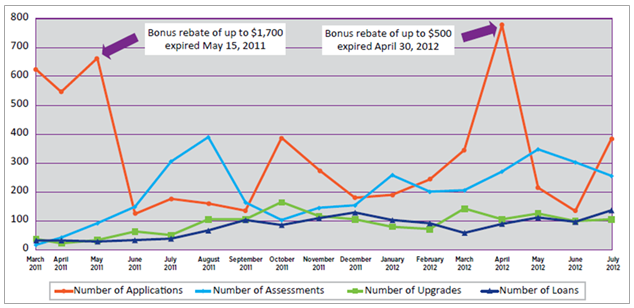Incentives can be the easiest approach to overcome motivation barriers and attract customers’ and contractors’ attention, as long as the upgrade and reimbursement processes are kept simple and easy to follow. Successful programs have found incentives help entice customers to complete upgrades, particularly during limited time offers when a deadline further motivates action. Because incentives are expensive for programs, determining the minimum level needed to achieve your goals or offering incentives for limited periods can be important strategies for success. Also, according to a comprehensive evaluation of more than 140 programs, successful programs were able to offer lower incentives than other programs that also had incentives.
- Efficiency Maine used large incentives during the program launch to create consumer demand for energy improvements and stimulate contractors’ interest in adapting their business models to accommodate more comprehensive energy upgrades. From January 2010 through May 2011, homeowners could receive a rebate for 30% of project costs, which could total up to $1,500 for comprehensive projects that were projected to achieve at least 25% energy savings. To further motivate consumer and contractor action, Efficiency Maine launched an additional, limited-time $1,000 bonus incentive in the summer of 2010. As Efficiency Maine’s rebate funds wound down in spring 2011, the program underwent a one-month transition period during which customers could qualify for both rebates and financing. This approach, in addition to contractor sales training, residential direct installs, and other program design features, contributed to the creation of a successful market for residential energy efficiency in Maine. Learn more in the U.S. Department of Energy case study, Spotlight on Maine: Transition to a Sustainable Level of Incentives.
- Michigan Saves, formerly BetterBuildings for Michigan, focused its incentive dollars on completing home energy upgrades rather than on energy assessments and direct install measures, after experimenting with various incentive designs from November 2010 through March 2012. When they adjusted the program’s incentive structure in this way, program staff saw the conversion rate from assessments to upgrades increase, depending on the neighborhood, from a range of 5-25% up to a range of 30-60%. The incentives for deeper energy upgrade packages, including air sealing and duct sealing, seemed to attract a higher percentage of the eligible population—20% to 30% participation for a package valued at around $1,000 versus 10% to 15% participation for a package valued at around $350. Learn more in the U.S. Department of Energy case study, Spotlight on BetterBuildings for Michigan: Experiment to Find the Right Mix of Incentives.
- To develop momentum for its Clean Energy Accelerator program, Austin Energy started off with a 3-month Best Offer Ever promotion from October 1 through December 31, 2010, that offered a combination of rebates from local utilities that varied based on work performed and interest rates that were bought down to 0%, representing an additional $1,200 in incentives per household compared to Austin Energy's typical offer. Contractors completed comprehensive energy upgrades in a record 568 homes in the six months after the campaign launch.
- In addition to its base rebate levels, Enhabit, formerly Clean Energy Works Oregon, offered limited-time bonus rebates on top of its $2,000 base rebates ($500 for the assessment and up to $1,500 for the upgrades) to grab the attention of potential customers. The first limited-time promotion occurred in spring 2011 and offered an additional $1,700 to the program’s base rebate. The second promotion was offered in March and April 2012 and added $500 to the base rebate. The program found that repeatedly offering bonus promotions attracted the attention of new customers each time, even as the program reduced the dollar amount of the bonus from $1,700 to $500.
Enhabit’s Applications, Assessments, Upgrades, and Loans Per Month
(March 2011 - July 2012)

Programs often discover that offering limited time incentives can bring about a sizable surge in assessment and upgrade requests. A few programs found that they were not sufficiently prepared for the additional work and lost interested customers because they could not get back to them quickly. Some programs added temporary staff for call centers when a big push was set to take place, or created a temporary pool of contractors to help with increased workloads; others scheduled their incentives to coincide with seasonal capacity.
- NeighborWorks of Western Vermont’s (NWWVT) Home Energy Assistance Team (H.E.A.T. Squad) incentivized homeowners to complete a home energy assessment by offering the assessment for $50, which was $200 less than the typical evaluation cost offered to Vermont residents through Efficiency Vermont. One year in, the program found that its contractors were struggling to keep up with surging demand for home energy upgrades. In 2011, NWWVT established LaborWorks@NeighborWorks (LaborWorks) as a nonprofit temporary labor pool to assist professional contractors involved with the H.E.A.T. Squad during busy periods when they could not keep up with demand or hire full-time help. The extra staffing helped reduce the number of backlogged projects.
- When planning its Best Offer Ever promotion, Austin Energy collaborated with contractors to account for their seasonal workload and launched the promotion during the fall and winter, typically the slow season for contractors in an otherwise sunny and hot region of Texas. This careful timing increased the likelihood of upgrades being completed in a timely manner and helped contractors avoid seasonal layoffs. Contractors completed comprehensive energy upgrades in a record 568 homes in the six months after the campaign launch.